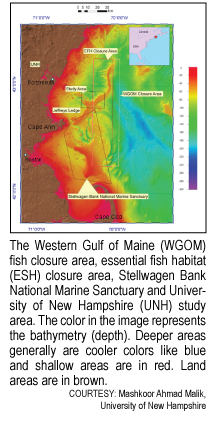|
Off Limits: Inside the Gulf of Maine
Closure Area
By Kirsten Weir
[printer friendly page]
Untold generations of New England
fishermen have made their livings in the fish-rich waters of
Jeffrey’s Ledge. Left behind by a glacier at the end of
the ice age, the rocky ledge roughly parallels the coast for
33 miles or 53 kilometers from Massachusetts to Maine. The ledge
itself is relatively shallow, but its edges drop off sharply.
At these margins, currents well up from the depths, carrying
nutrients that fuel a diverse marine ecosystem.
Over the last decade, however,
tightened fishing regulations have placed much of this storied
ledge off-limits to commercial fishermen. Now, scientists and
fisheries managers are taking a careful look at the Western Gulf
of Maine Closure Area, hoping to understand how it has affected
both the fishing industry and the ecosystem. In March 2007, scientists,
regulators, fishermen and others met at a symposium at the University
of New Hampshire (UNH) to discuss the effects of the closure.
The number of cod in the Gulf
of Maine plummeted by nearly half from 1986 to 1996. Hoping to
stem the crisis, the New England Fishery Management Council implemented
a number of regulations, from increasing the size of mesh used
in nets to limiting the number of days fishermen could spend
at sea. In 1998, the Management Council created the Western Gulf
of Maine Closure Area. The 1,100-square-mile (2,849-square-kilometer)
zone, containing much of Jeffrey’s Ledge, was closed to
commercial groundfishing.
 Habitat
protection Habitat
protection
Initially, the closure was established simply to reduce the number
of cod being caught, Tom Nies, a senior fishery analyst at the
Management Council, told the symposium audience. “It was
chosen to be closed because people were catching a lot of fish
there,” he said. The Council’s original plan was to
shut the area for three years. But over the years, a series of
amendments extended the closure indefinitely and added an explicit
habitat-protection component as well. The Western Gulf of Maine
Closure Area’s goals now include protecting essential fish
habitat in addition to allowing cod stocks to rebuild.
Nine years after the closure
area was established, scientists are beginning to understand
the effects it has had on the habitat and the fishery. But piecing
together the puzzle is no small task. Possible effects of the
closure are confusingly intertwined with the effects of regulations
on net mesh sizes, days-at-sea limitations and catch limits.
Also, as Gulf of Maine Research Institute scientist Jonathan
Grabowski pointed out, no detailed baseline studies were done
before the area was closed. Scientists can compare habitat inside
and outside the closure, but they can’t compare present
conditions there to those of the recent past.
Still, scientists are starting
to draw some broad conclusions. For instance, UNH zoologist Ray
Grizzle found that on the rocky seafloor habitat common to Jeffrey’s
Ledge, invertebrate creatures such as sea squirts, sponges and
anemones were more abundant inside the closure than just outside
it.
“There’s a basic understanding
that the habitats are recovering,” Grabowski explained in
an interview. Still, it’s not clear how that recovery is
affecting cod and other commercially important groundfish. He’s
studied how the closure may affect juvenile fish. In general,
he said, juvenile groundfish tend to hang out in structured habitat,
the gravely bottoms and rocky ledges where they can hide from
predators and forage for food. But the link between seafloor
recovery and the health of groundfish populations isn’t
straightforward. In separate studies, both Grizzle and Grabowski
caught cod inside the closure area, but they both hauled in fewer
juveniles than they expected to find.
Impact on adult groundfish
Other researchers have focused on adult fish. Recent studies
have suggested the closure area has had little impact on the
movement patterns of adult groundfish in the region. Cod in particular
are very mobile and may not be spending enough time inside the
closure area to reap the benefits of protection.
While the jury is still out on
whether cod benefit from the closure, evidence suggests that
local fishermen may not. At the UNH symposium, Massachusetts
Institute of Technology anthropologist Madeline Hall-Arber said
she has found that increasingly strict fishing regulations have
created hardships for the owners of small vessels, and placing
much of Jeffrey’s Ledge off-limits has affected the way
many have fished for generations. For example, she said, the
closure has encouraged small boats to fish farther offshore than
is safe for vessels of their size.
Hall-Arber said many fishermen
recognize the importance of rebuilding the fish populations,
but they’d like to be sure that the regulatory red tape
is having a positive impact. When it comes to the closure area,
it may be a while before the picture is clear. Researchers agree
that more work is needed to understand the closure’s impact.
For now, it remains closed indefinitely.
“You can often document
changes in the habitat. You can see more things growing on the
bottom, more diversity of species,” Nies of the New England
Fisheries Management Council said in an interview. “The
big question that is hard to unravel is ‘What does it do
to the [groundfish] resource as a whole?’ Quite honestly,
I think it’s going to take time to figure out the answers.”
Kirsten Weir is a free-lance writer in Saco, Maine, who focuses
on science, health, and the environment.
|
![]()
